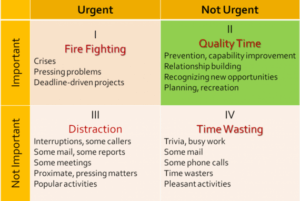“It is not enough to be busy…The question is: what are we busy about?”
Henry David Thoreau
A tale of time (mis)spent
A recent coaching client complained that she works long hours, and struggles to fit everything into the working day. Her days at work are either taken up with responding to emails, or spent running from one meeting to the next. These meetings – which often overrun – usually end up with no concrete results. Quick fixes are constantly being sought to overcome problems. In fact, the same problems keep re-occurring and are revisited several times every year. Does this all sound familiar to you to?
What are the major problems in this client’s organisation? Many interesting facts emerged from our discussions. There seems to be a distinct lack of forward planning and the tendency within her team is to adopt the first, easiest and most obvious solution when faced with an issue or challenge. They are falling back onto habitual responses which might seem like a way to use less energy and consume less time when situations seem urgent but they are all deluding themselves.
This client – and her whole organization – are allowing themselves to be driven by circumstances and are constantly running to catch up. It should come as no surprise to find that people who operate like this are constantly stressed and worn out from patching over the cracks. The focus of their attention needs shifting and bad habits need replacing with good ones so that they can get their priorities in the right order and organise their time accordingly.
Their challenge is to become the masters of their time, instead of allowing time to be the master of them. Here is one way that they could tackle this issue.
The Time Management Matrix
The Covey time management matrix is an effective method of organising priorities. It differentiates between activities that are important and urgent, important but not urgent, important and urgent and those that are not important and not urgent.

“Time management is really a misnomer – the challenge is not to manage time but to manage ourselves.”
Stephen R. Covey
Covey advises us to classify our tasks into four categories; things that are important, not important, urgent or not urgent. Quadrant II activities (important but not urgent, top right in the matrix above) are the heart of effective personal management. The real skill is to is to create time to focus on important things before they become urgent and consume your time and resources unnecessarily. Sometimes this just means doing things earlier. Sometimes it means investing time to come up with longer-term, more sustainable solutions that really meet the needs of the problem rather than getting stuck in a short-term or persistent cycle of fire-fighting. For example, maintaining good client relationships might reduce the need to rely solely on acquiring new clients. It might also involve identifying processes that enable you to do things more quickly or more easily, or ensure that they get done automatically. Examples would be clearing your desk and doing the filing, creating a daily to-do list (and a discipline to use it). By investing in specific times for the important activities you will ultimately and somewhat paradoxically be freeing up time to fit in the less important ones too.
This is a simple but very powerful tool. By using this matrix as a funneling mechanism it can bring focus and order to your busy workplace and your workdays.
What can you do to put “first things” first and then execute and organise yourself around those things?
You might also enjoy the tip Encourage change at work from our Treasure Chest

